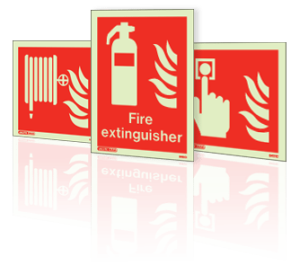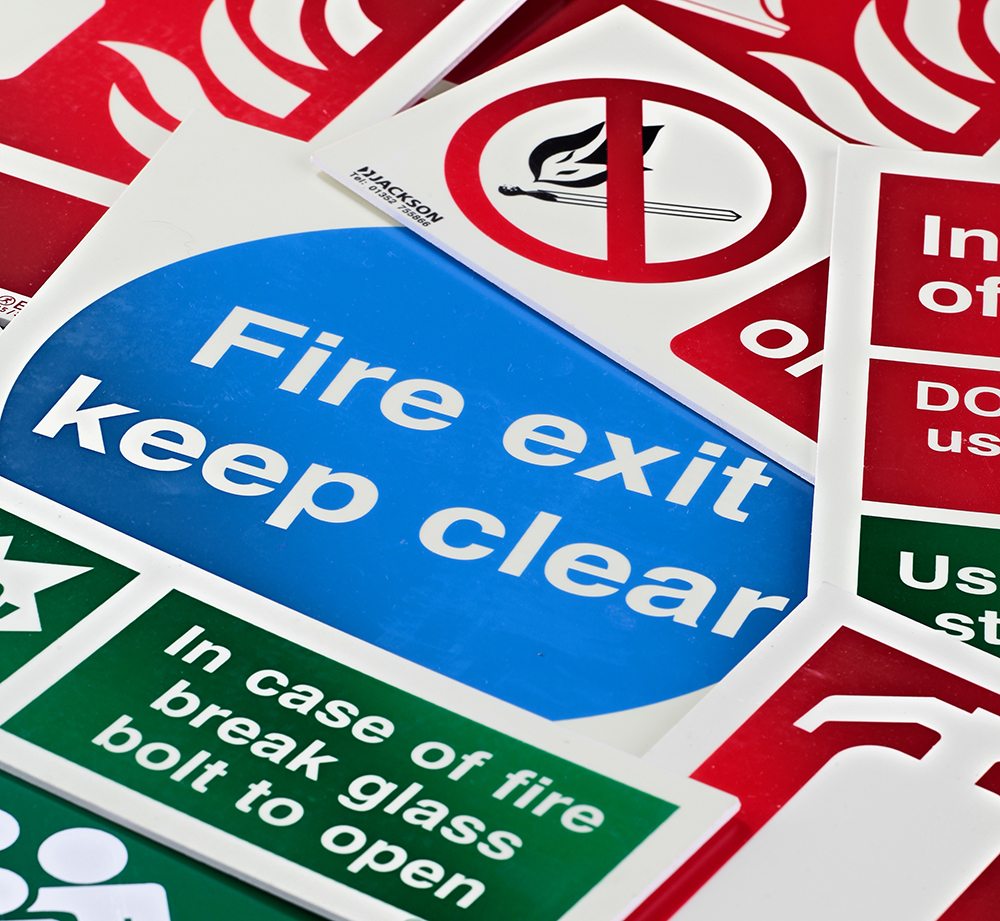It’s likely you walk past all kinds of safety signage every day and don’t give them a second thought. But safety signs play several important roles. They might be needed to clearly warn of a hazard. They can identify prohibited actions (like smoking) and illustrate any safeguards that must be followed. They can direct people towards fire exits, fire-fighting equipment or other kinds of health and safety equipment such as first-aid kits. Ultimately they could contribute to saving a life.
The key regulations you need to comply with are the Health and Safety (Safety Signs and Signals) Regulations 1996 but there will be other specific legislation you must also adhere to depending on the nature of the sign. For fire safety signage, you need to be fulfilling the requirements of the Regulatory Reform (Fire Safety) Order 2005 at the same time.
Is your fire safety signage up to date? Fire safety signs are generally used to provide information on escape routes and emergency exits in the event of fire and to provide information that helps with identifying or locating fire-prevention, fire-warning and fire-fighting equipment and systems.
The main colours used are red to indicate equipment and systems and green to indicate emergency escape information such as escape routes, doors and exits. But you may also come across other colours: a yellow or amber sign means be careful and take precautions. It could be used, for example, to indicate flammable materials. Mandatory notices are blue and are used to highlight specific behaviours or actions required. For instance, a fire door should display a blue sign telling people what it is and that it must be kept shut to reduce the risk of it being left propped open.
Escape route and emergency exit signs need to show the shortest way possible to a final exit. They should not be used along with or close to another directional sign as it might confuse people. Locate signs at every decision-making point so people know where to go next without losing time. Any doors that use security devices, particularly doors that could specifically be used for escape, should display fire safety signs that show how to open them quickly for maximum speed of escape.
Fire safety signs are generally used to provide information on escape routes and emergency exits in the event of fire and to provide information that helps with identifying or locating fire-prevention, fire-warning and fire-fighting equipment and systems.
The main colours used are red to indicate equipment and systems and green to indicate emergency escape information such as escape routes, doors and exits. But you may also come across other colours: a yellow or amber sign means be careful and take precautions. It could be used, for example, to indicate flammable materials. Mandatory notices are blue and are used to highlight specific behaviours or actions required. For instance, a fire door should display a blue sign telling people what it is and that it must be kept shut to reduce the risk of it being left propped open.
Escape route and emergency exit signs need to show the shortest way possible to a final exit. They should not be used along with or close to another directional sign as it might confuse people. Locate signs at every decision-making point so people know where to go next without losing time. Any doors that use security devices, particularly doors that could specifically be used for escape, should display fire safety signs that show how to open them quickly for maximum speed of escape.
 Fire safety signs are generally used to provide information on escape routes and emergency exits in the event of fire and to provide information that helps with identifying or locating fire-prevention, fire-warning and fire-fighting equipment and systems.
The main colours used are red to indicate equipment and systems and green to indicate emergency escape information such as escape routes, doors and exits. But you may also come across other colours: a yellow or amber sign means be careful and take precautions. It could be used, for example, to indicate flammable materials. Mandatory notices are blue and are used to highlight specific behaviours or actions required. For instance, a fire door should display a blue sign telling people what it is and that it must be kept shut to reduce the risk of it being left propped open.
Escape route and emergency exit signs need to show the shortest way possible to a final exit. They should not be used along with or close to another directional sign as it might confuse people. Locate signs at every decision-making point so people know where to go next without losing time. Any doors that use security devices, particularly doors that could specifically be used for escape, should display fire safety signs that show how to open them quickly for maximum speed of escape.
Fire safety signs are generally used to provide information on escape routes and emergency exits in the event of fire and to provide information that helps with identifying or locating fire-prevention, fire-warning and fire-fighting equipment and systems.
The main colours used are red to indicate equipment and systems and green to indicate emergency escape information such as escape routes, doors and exits. But you may also come across other colours: a yellow or amber sign means be careful and take precautions. It could be used, for example, to indicate flammable materials. Mandatory notices are blue and are used to highlight specific behaviours or actions required. For instance, a fire door should display a blue sign telling people what it is and that it must be kept shut to reduce the risk of it being left propped open.
Escape route and emergency exit signs need to show the shortest way possible to a final exit. They should not be used along with or close to another directional sign as it might confuse people. Locate signs at every decision-making point so people know where to go next without losing time. Any doors that use security devices, particularly doors that could specifically be used for escape, should display fire safety signs that show how to open them quickly for maximum speed of escape.
- Equipment and systems

